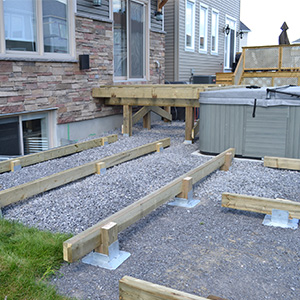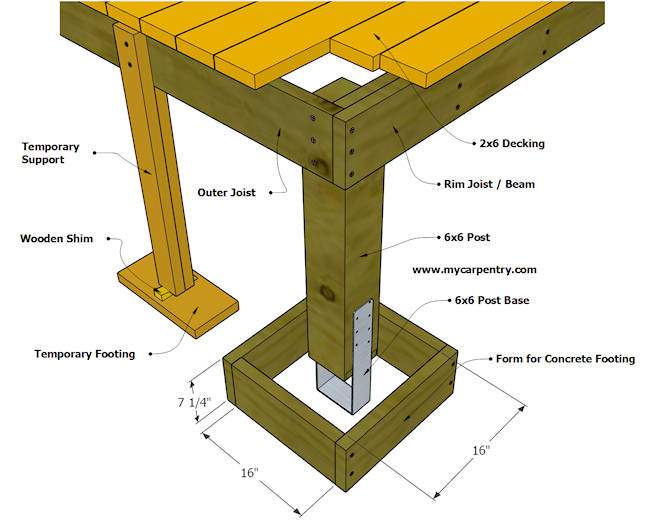Optimize the Life-span of Your Deck With Trusted and Solid Grounds
As property owners, we invest a considerable amount of time and sources right into creating the perfect outside room. A deck is often the centerpiece of that space, offering an area to relax, amuse, and appreciate the beauty of nature. In order to fully take full advantage of the life expectancy of your deck, it is vital to make certain that it is constructed on trusted and solid grounds. These grounds create the foundation of your deck, providing security and assistance, and are typically the difference between a deck that lasts for years and one that requires consistent repair work. In this conversation, we will check out the importance of trustworthy footings, the various kinds of strong ground materials, appropriate installation strategies, and exactly how to maintain and check your deck's footings to protect against damage. Whether you are in the procedure of looking or developing a brand-new deck to boost the longevity of your existing one, join us as we uncover the tricks to a deck that stands the examination of time.
Significance of Trustworthy Footings
The relevance of dependable footings can not be overemphasized when it comes to optimizing the life-span of your deck. The footings work as the structure whereupon the whole structure relaxes, giving stability and support. Without a strong ground, the deck is susceptible to shifting, sinking, and even collapse, which can substantially lower its life-span and pose safety risks.

Choosing the appropriate type of ground is also crucial. The most usual kinds consist of concrete footings, helical piers, and sonotubes. Elements such as dirt problems, environment, and the size of the deck will certainly identify the most appropriate alternative. Employing a specialist to examine the dirt, style the footings, and make sure appropriate installment is highly suggested.
Investing in reputable footings may include additional cost and effort upfront, but it is a worthwhile financial investment that will certainly add to the long-lasting longevity and safety and security of your deck. By making certain a solid structure, you can enjoy your deck for numerous years to find, understanding that it is built to endure the test of time.
Types of Solid Ground Products
To make certain the security and long life of your deck, it is necessary to take into consideration the numerous kinds of solid ground products offered. The option of footing material is essential as it offers the required support and stability to hold up against the weight and tons of the deck framework.
One usual and trusted product used for deck grounds is concrete. Concrete grounds are resilient and provide excellent security. They can be poured straight into the ground or use precast concrete footings for less complicated setup. Another alternative is helical piers, which are steel shafts with helical plates that are screwed into the ground. These piers use outstanding load-bearing capacity and can be made use of in different dirt conditions.
For areas with poor soil conditions, such as large or loose soils, a ground system that utilizes steel or composite piers may be preferred. Deck Footings. These piers are driven deep into the ground to get to stable dirt layers, ensuring the security of the deck
In many cases, deck grounds can additionally be built using cured lumber. It is vital to guarantee that the lumber is appropriately dealt with to stand up to rot and decay caused by exposure to wetness and pests.
When picking a ground material for your deck, it is important to think about variables such as dirt problems, climate, and local building ordinance. Consulting with an expert specialist or architectural designer can assist figure out one of the most suitable footing material for your specific deck project.
Proper Setup Methods for Grounds
Thinking about the relevance of ensuring stability and resilience for your deck, it is vital to comprehend the correct installment strategies for grounds. The success of your deck task counts greatly on the honesty of its structure, which is why following the appropriate installment techniques is essential.
Most importantly, it is required to figure out the proper dimension and deepness of the footings based on the design and load requirements of your deck. This info can be acquired from developing codes or with examination with a structural engineer. As a general guideline, footings ought to go to least 12 inches in diameter and prolong below the frost line to stop settling or shifting.
Once the dimensions are developed, the next step is excavation. Digging the holes for the footings need to be finished with accuracy, ensuring they are deep sufficient he said and have a degree base. Deck Footings. This will certainly give a steady base for the footings
To even more improve the stability of the grounds, it is recommended to use a concrete mix with a stamina of at least 3,000 psi. This will make certain the grounds can stand up to the weight and forces put in by the deck.
Throughout setup, it is necessary to keep the grounds level and straightened correctly. This can be achieved by using a degree and string lines to lead the positioning of each footing.
Maintaining and Checking Your Deck's Footings
Routine maintenance and comprehensive evaluations are important for guaranteeing the long-lasting security and safety of your deck's footings. With time, grounds can give in to damage, weather, and dirt activity, which can compromise their structural stability. To take full advantage of the life-span of your deck's footings, it is important to apply a regular maintenance regimen and perform extensive assessments.

In addition, it is vital to inspect grounds for any kind of signs of damages or wear and tear. This consists of monitoring for fractures, divides, or crumbling concrete, in addition to any kind of signs of motion or negotiation. Any problems need to be attended to quickly to protect site link against further damage and ensure the stability of the deck.
In addition, it is recommended to check the bordering soil for any type of signs of erosion or changing. Soil activity can affect the security of the footings, so it is very important to attend to any kind of soil-related problems immediately.
Signs of Footing Damage and Just How to Address Them
Footing damages can position serious dangers to the stability and safety and security of your deck, making it important to without delay identify and address any type of indicators of damage. Among one of the most usual indicators of footing damages is sinking or settling of the deck. This can occur due to soil erosion, inadequate grounds, or inadequate building and construction techniques. If you see that your deck is irregular or leaning, it is critical to take prompt activity to stop additional damage. One more sign of footing damage is collapsing or splitting of the concrete grounds. This can be triggered by freeze-thaw cycles, excessive moisture, or low quality concrete. If you observe any type of cracks or deterioration in the grounds, it is essential to have them examined and repaired by a specialist. In addition, if you see any type of movement or changing of the deck, such as a deck that really feels unsteady when walked on or totters when weight is used, maybe a sign of footing damages. In such instances, it is recommended to speak with an architectural engineer or a professional contractor to examine the degree of the damages and establish the suitable strategy. Remember, resolving ground damage without delay can aid ensure the lasting security and safety of your deck.
Verdict
In final thought, making sure the dependability and stamina of footings is essential for optimizing the life Discover More expectancy of your deck. By utilizing strong footing products and effectively mounting them, you can stop damages and keep the security of your deck.
These footings form the structure of your deck, supplying stability and support, and are often the distinction between a deck that lasts for decades and one that calls for consistent repair services. In this discussion, we will certainly discover the value of trusted grounds, the different kinds of solid footing products, correct setup techniques, and how to maintain and evaluate your deck's grounds to prevent damages.Normal maintenance and thorough examinations are crucial for making certain the long-lasting security and security of your deck's footings. Bear in mind, resolving footing damage quickly can help make certain the lasting security and security of your deck.
By using solid footing products and appropriately installing them, you can protect against damage and keep the stability of your deck.